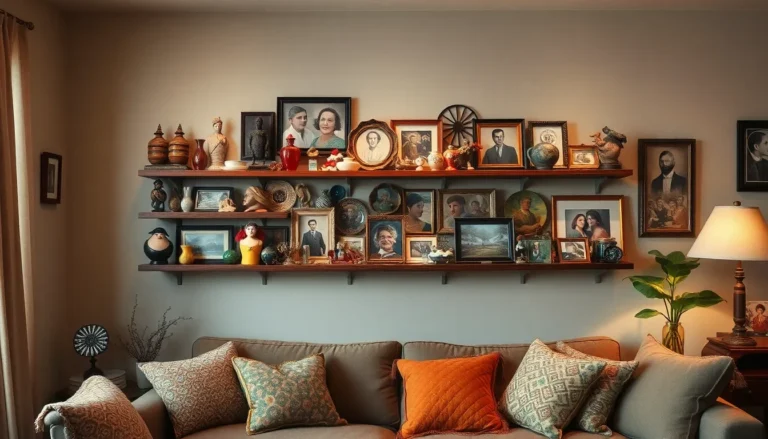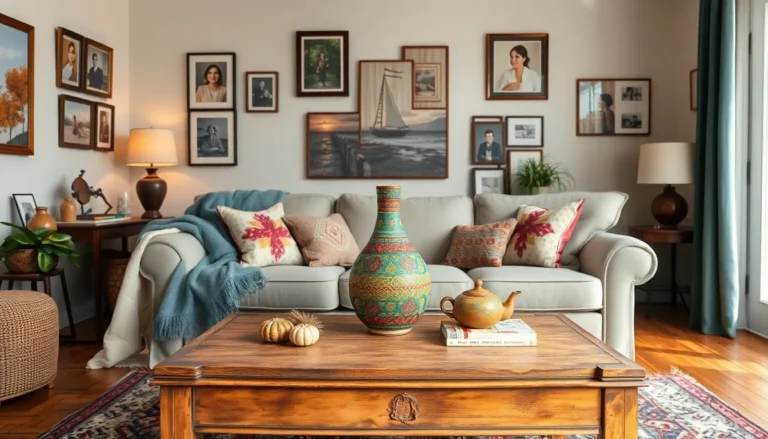When it comes to setting the mood in any space, layered lighting warmth is the unsung hero. Imagine walking into a room that feels like a warm hug after a long day—inviting, cozy, and just a little bit magical. It’s not just about flipping a switch; it’s about creating an atmosphere that wraps around you like your favorite blanket.
Layering different types of lighting can transform a cold, sterile environment into a welcoming haven. Whether it’s the soft glow of table lamps, the gentle flicker of candles, or the dramatic flair of pendant lights, each layer adds depth and personality. So why settle for a bland, one-size-fits-all approach to lighting? Dive into the world of layered lighting warmth and discover how to make your space as inviting as a cup of hot cocoa on a winter’s night.
Table of Contents
ToggleUnderstanding Layered Lighting Warmth
Layered lighting warmth creates an inviting environment that enhances any space. Utilizing varied light sources transforms the overall ambiance, making it feel cozier.
Definition of Layered Lighting
Layered lighting consists of combining three key types of lighting: ambient, task, and accent. Ambient lighting provides overall illumination, ensuring the space feels bright and welcoming. Task lighting focuses on specific areas, allowing for activities like reading or cooking without straining eyes. Accent lighting highlights features like artwork or architectural details, adding depth to a room. This combination results in a balanced and harmonious atmosphere, crucial for achieving desired warmth.
Importance of Warmth in Lighting
Warmth in lighting significantly influences mood and comfort. It promotes relaxation, making spaces feel more welcoming. A warm light, typically characterized by a lower color temperature, mimics natural sunlight, contributing to a sense of well-being. Bright, cool lighting may create a sterile feel, while warm lighting encourages social interaction and leisure. By incorporating warm light sources, such as soft white bulbs or candles, individuals can enhance the overall experience within their homes.
Benefits of Layered Lighting Warmth

Layered lighting warmth creates inviting spaces that enhance comfort and well-being. It combines different lighting types to transform any environment.
Enhancing Mood and Ambiance
Layered lighting significantly influences mood and ambiance. Warm light promotes relaxation and encourages social interaction. Strategically placed accent lighting highlights features and adds visual interest. Different fixtures, like table lamps and floor lamps, contribute to a cozy atmosphere. Combining these elements can create a sense of harmony and tranquility throughout the space, inviting people to unwind.
Improving Functionality in Spaces
Layered lighting enhances functionality across various areas in a home. Task lighting focuses illumination on specific tasks, such as reading or cooking, making activities easier and safer. Ambient lighting provides general illumination for daily use. By integrating both types, homeowners improve usability without sacrificing comfort. Adjustable fixtures allow users to customize brightness levels, catering to different needs throughout the day.
Types of Layered Lighting
Different types of layered lighting play distinct roles in enhancing the warmth of a space. Understanding these categories helps in creating a well-balanced and inviting atmosphere.
Ambient Lighting
Ambient lighting serves as the foundation for overall illumination in a room. It fills the entire space with a soft, diffuse glow, ensuring comfort without harsh shadows. Common sources include ceiling fixtures, recessed lights, and floor lamps. Warm LEDs often provide a cozy backdrop, mimicking the qualities of natural light. Each element contributes to a harmonious setting, allowing for relaxation or social interaction. Homeowners can adjust brightness levels through dimmers to suit various activities. This flexibility ensures that ambient lighting caters to every moment throughout the day.
Task Lighting
Task lighting focuses on specific areas to facilitate activities such as reading or cooking. It provides concentrated illumination exactly where it’s needed, enhancing functionality in home settings. Examples consist of desk lamps, under-cabinet lights, and pendant lamps over workspaces. Positioning these fixtures correctly ensures optimal visibility and minimizes eye strain. Selecting warm-colored bulbs enhances comfort during intricate tasks. By integrating task lighting, individuals increase productivity while maintaining a cozy atmosphere. Each task-specific light serves to complement the ambient illumination, adding layers of visual interest.
Accent Lighting
Accent lighting emphasizes particular features, creating visual focal points within a space. It adds depth and dimension, drawing attention to artwork, architectural details, or plants. Common examples include wall sconces, track lighting, and decorative table lamps. Warm hues enhance the allure of these highlighted elements, infusing the environment with charm. Using accent lighting offers homeowners the opportunity to express their personal style. Balance accent lights with ambient and task options to achieve a cohesive look. Each layer adds to the overall warmth, making the space feel inviting and stylish.
Tips for Achieving Layered Lighting Warmth
Creating layered lighting warmth involves thoughtful considerations in bulb selection and color temperature that enhance the overall ambiance of a space.
Choosing the Right Bulbs
Selecting appropriate bulbs plays a crucial role in achieving warmth. LED bulbs offer energy efficiency while mimicking the qualities of natural light. Bulbs with a warm color temperature, typically between 2700K and 3000K, create a cozy atmosphere. Opt for dimmable options to easily adjust brightness based on mood and activity. Also, soft white bulbs provide a gentle glow ideal for living spaces, while warmer tones in pendant lights enhance social areas. Consider using decorative bulbs to add a stylish touch alongside functionality.
Color Temperature Considerations
Understanding color temperature deeply influences the warmth of layered lighting. Warmer color temperatures evoke feelings of comfort and welcoming environments, making them suitable for living rooms and bedrooms. Cooler tones, such as those above 3500K, may serve better in workspaces, fostering alertness. Mixing different color temperatures within a single space can establish balance and visual interest. Incorporating warm tones in ambient lighting and slightly cooler tones in task lighting promotes harmony. A consistent color palette throughout the layers ensures an inviting atmosphere that encourages relaxation.
Layered lighting warmth is essential for creating inviting and comfortable spaces. By thoughtfully combining ambient, task, and accent lighting, individuals can transform their homes into cozy retreats. The right choice of bulbs and color temperatures plays a crucial role in achieving this atmosphere.
Incorporating warm light can significantly enhance mood and promote relaxation. Dimmable options allow for flexibility, ensuring that the lighting adapts to various activities throughout the day. Ultimately, embracing the concept of layered lighting not only elevates the aesthetic appeal of a home but also fosters a sense of well-being and connection among those who inhabit it.



